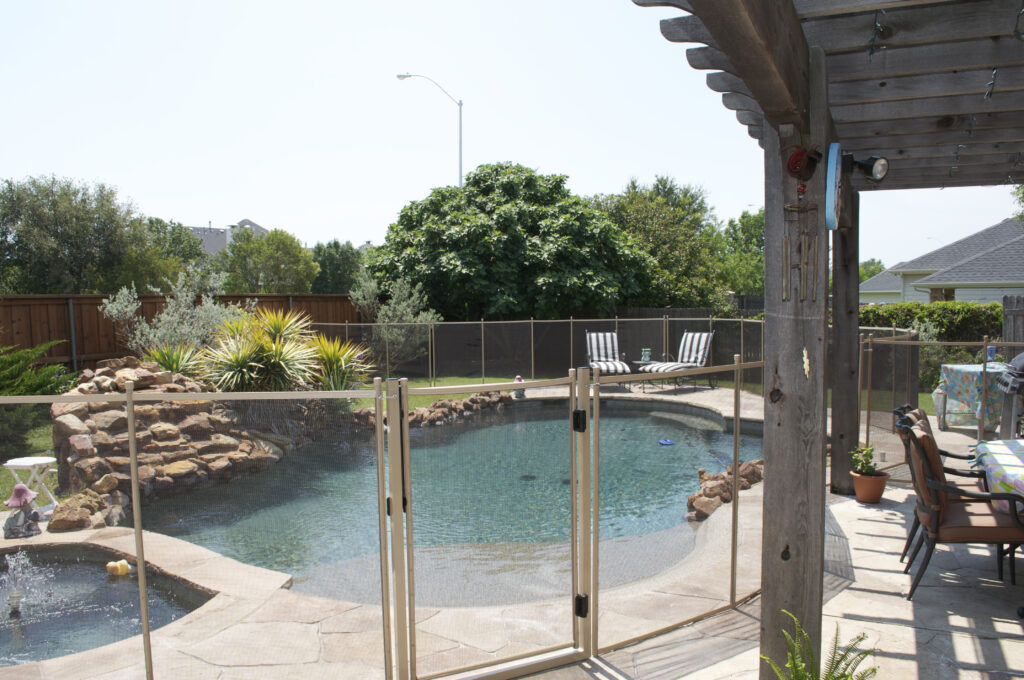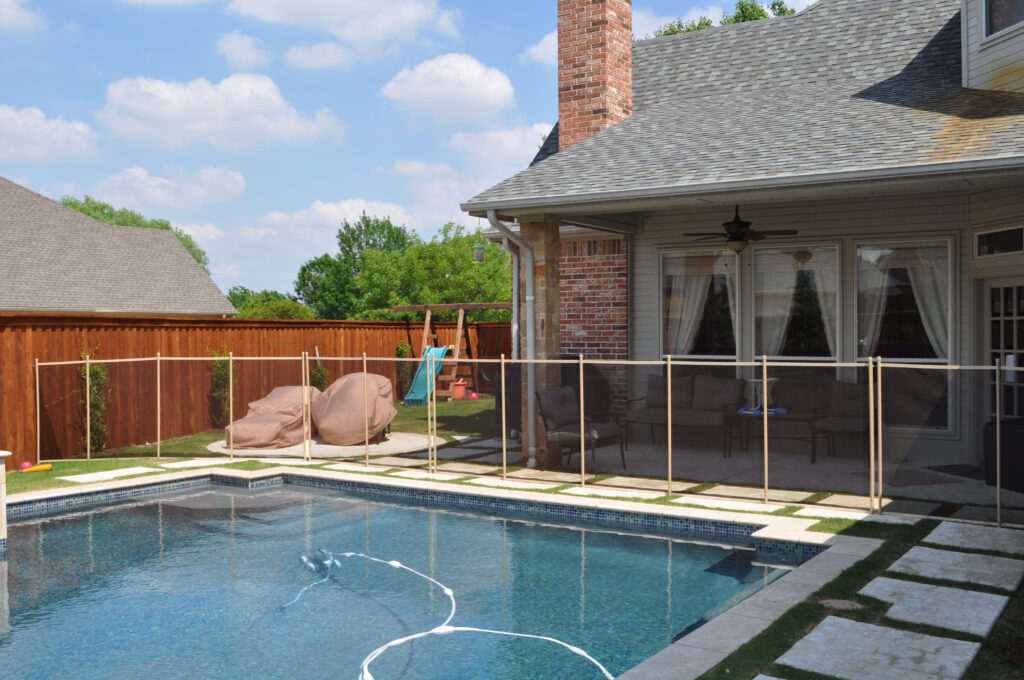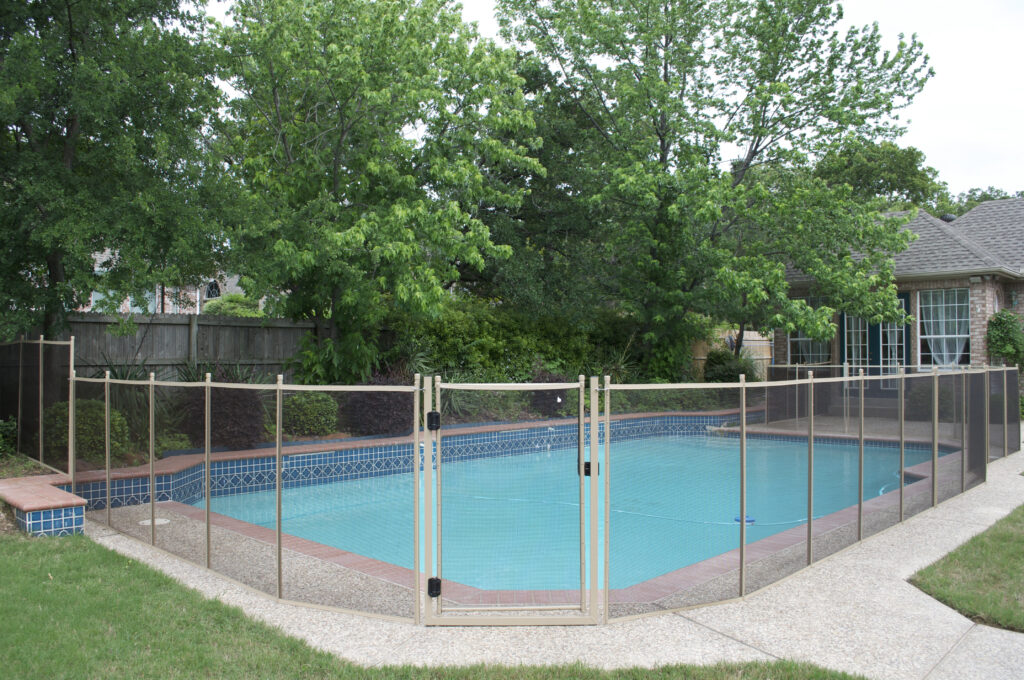Drowning remains the leading cause of unintentional death for children ages 1 to 4, and many states now require code-compliant barriers for added safety. But for many homeowners, the overall pool fence installation cost may be confusing and difficult to grasp.
From material selection to site prep, many factors influence the final price.
Ready to secure your pool the right way? Let’s break down what pool fence installation really costs and how to budget smartly without compromising safety.

Pool fence installation cost refers to the total expense of installing a compliant safety barrier around your pool. This includes:
At Pool Guard™, we professionally install pool fences using high-quality materials and code-compliant designs tailored to your needs. Whether you’re securing a small backyard pool or a large custom layout, we handle every part of the process—from layout planning to final inspection.
Total installation costs typically range from $1,500 to $10,000, with most homeowners paying around $4,000. What’s the cause of such extreme cost variation?
First of all, not every pool is created equal, and that’s exactly why the cost can swing from $1,500 to $10,000 for premium installation. The price you’ll pay depends on a handful of key factors that come into play as soon as you start planning.
First, the type of material you choose has a major impact.
ASTM-compliant mesh fencing is typically the most affordable, with budget mesh panels running as low as $7 per linear foot, while glass and wrought iron sit at the top of the price range due and can pass $600 per foot to their design complexity and labor demands.
These premium materials offer a sleek, high-end look and long-term durability, but they also require specialized hardware, precision installation, and more labor-intensive work. There are also mid-range options like vinyl, which is low-maintenance and customizable, or wood, which offers privacy and a classic aesthetic but demands regular upkeep.
Before you pick a style for its look, compare the pool safety fence cost per-foot and factor in long-term durability and maintenance.
Material choice drives the largest variation in the cost of pool fence installation. Below, you’ll find the typical installed pool fence price range per linear foot for each option, along with key benefits and considerations to help you weigh style against budget.
| Material | Cost per linear foot |
| Mesh | $19-$32 per linear foot |
| Chain-link | $17–$46 per linear foot |
| Vinyl | $27–$42 per linear foot |
| Wood | $27–$42 per linear foot |
| Aluminum | $32–$57 per linear foot |
| Plexiglass | $32–$52 per linear foot |
| Tempered glass | $112–$622 per linear foot |
Fence height plays a bigger role in your pool safety fence cost than most people realize. Taller fences naturally require more material, and when you add in decorative elements like scrollwork, custom colors, or designer post caps, the labor involved becomes more specialized, too.
Building codes vary by state and sometimes even by city or county, and each jurisdiction sets its minimum height requirement for pool barriers. In many areas, the minimum is 48 inches, while others, especially those following the International Swimming Pool and Spa Code (ISPSC), require 60 inches or more.
On top of the cost of the required fence height, choosing the wrong height could mean failing inspection or being forced to redo parts of the fence after installation.
For example, a standard 48-inch aluminum fence may cost $30/ft, while a 60-inch version with a powder-coat finish and scrollwork could push beyond $50/ft. Always confirm the minimum height requirements in your jurisdiction before choosing a more elaborate design.
The size and shape of your pool directly affect the pool fencing cost. Fence installers typically charge by the linear foot, so the longer your pool’s perimeter, the more material, posts, anchors, and labor you’ll require.
A small rectangular pool might need just 100 feet of fencing, while a large or irregularly shaped pool, like a kidney or freeform design, can easily push that number higher.
Your yard’s layout can significantly impact labor costs. If the area around your pool is flat, level, and easily accessible, installation tends to go quickly. But if you have sloped terrain, rocky soil, dense landscaping, or limited access, your installer may need to spend extra time preparing the site. This could involve grading, digging through hard soil, or navigating tight corners, all of which add to labor hours and sometimes require specialized equipment.
For example, rocky soil might require jackhammering or concrete anchors, while a steep hill may mean stepping posts or additional support brackets. These complexities often make up the “hidden cost of pool fence installation” in many pool fence quotes, so it’s important to talk everything through with the installer when coming up with the total pool fence installation price.
Many cities and counties require a building permit before a pool fence can be installed, and each has its own rules. Some jurisdictions may only ask for a basic permit and a quick inspection, while others require engineered drawings, multiple inspection visits, or additional safety features like alarms or specific latch types. Fees typically range from $40 to $150, but can be higher in areas with strict zoning or homeowner association rules.
Failing to pull the proper permits can result in fines, stop-work orders, or forced removal of non-compliant fencing. That’s why it’s critical to confirm local requirements and include permit costs and timelines in your overall project plan.

Once you have the basic fence panels set in place, a handful of add-ons can elevate both safety and convenience. Below are some of the most common and code-required features that homeowners should include alongside their fencing panels.
To be fully ASTM compliant, a pool fence must include a gate during its installation stage. The pool gate installation cost on a pool safety barrier ranges from $200-$900 per gate assembly, with the price varying mostly from the material type.
Self-closing hinges use springs or hidden magnets to automatically swing the gate shut, while latches mounted at least 54 inches off the ground keep curious toddlers from reaching them. In many jurisdictions, gates must also open outward, away from the pool deck, and feature hardware that resists corrosion in wet conditions. All these requirements only add to the final estimate.
Pairing a fence with an alarm system in accordance with UL 2017 creates a double layer of protection, alerting you if someone breaches the barrier or stray waves disturb the water. Surface-wave alarms detect motion on the pool’s surface and typically run $100–$220. Door-mounted or gate alarm bolts are not that costly and are usually priced from $40-$80.
If you want your pool fence to scream luxury, all those extras only add to the price. Extras like lighting, post caps, and custom paint tie your fence into the rest of your backyard aesthetic while adding practical benefits. LED-topped post caps illuminate pathways and pool edges after dark, costing about $20–$50 each.
Metal fences often receive a powder-coat finish for durability and color variety; professional powder-coating runs $50–$70 per hour.
Wood panels require periodic staining or painting. Expect painter rates of $25–$70 per hour to maintain moisture resistance and freshen up the look.
By factoring gates, alarms, and decorative touches into your budget, you’ll end up with a pool fence that’s not just compliant but genuinely user-friendly. These extras provide peace of mind and help your barrier blend seamlessly with your backyard retreat.
Before estimates solidify, installers will assess everything from soil composition to existing landscaping. These site-specific challenges often translate into extra labor hours, specialized equipment, and additional materials, resulting in higher pool fence pricing.
Uneven or rocky ground demands extra care. On a gentle slope, posts may need to be cut in a stepped pattern or fitted with angled brackets, processes that tack on $2–$5 per post in specialty hardware. In hilly backyards, crews might spend hours hand-digging holes or installing temporary retaining walls, slowing progress and driving labor rates toward the higher end of the $30–$80 per hour range. Rocky soil often requires jackhammers or rock augers; if heavy machinery is needed, anticipate additional equipment fees.
Prepping the site is a crucial early step—and a common source of unplanned expenses. Typical tasks include:
Underestimating these steps often leads to installation delays. A thorough prep phase keeps crews on schedule and your project on budget.
Your pool’s perimeter length directly dictates the amount of panels, posts, anchors, and labor required, and every extra foot adds to the total. By taking accurate measurements up front, you’ll avoid surprises on your final invoice and can compare quotes on a level playing field.
To measure the linear footage of your pool fence:
That total is your fence perimeter. Multiply it by your chosen material’s installed price per linear foot to get a baseline material + labor estimate, before factoring in gates, permits, or site prep.
Pools come in all shapes, and the more curves you have, the more posts and specialized fittings you’ll need:
Complex layouts can tack on 10%–15% more in labor costs compared to a simple rectangle, so account for that when requesting quotes.
For a more accurate estimate, check our pool fence installation cost calculator to help you get a general idea of pool fence installation costs. Please note that this is only an estimate, and actual pricing may vary depending on site conditions, materials, and local requirements. Final costs will be confirmed when you schedule your free estimate.
When terrain and prep work are factored in, labor can account for up to 50% of your total cost. Most pool-fence installers charge $30–$80 per hour, with the final rate influenced by regional demand and job complexity. A simple 150-foot mesh fence on flat ground might take two installers a single day, whereas the same run on rocky terrain could require extra hands or specialized drill bits, extending both labor hours and costs.
To minimize surprises, request itemized bids that separate labor, materials, permits, and site prep. If you can handle minor tasks, like brush clearing or demolition, you’ll know exactly how many hours you’re shaving off the labor invoice. And should an installer uncover unexpected challenges, you can discuss alternatives (for example, surface-mounted posts versus concrete footers) armed with a clear understanding of price versus performance trade-offs.
Installing a pool fence almost always requires a building permit, and skipping this step can lead to costly setbacks. Most jurisdictions ask for a permit application that includes your fence layout, materials, and gate locations. Fees typically range from $40 to $150, though complex reviews or additional inspections may increase that amount. Depending on your city, you may need pre-installation, mid-project, and final inspections to confirm code compliance. Delays in approval can hold up your timeline, so it’s smart to apply early and monitor progress closely.
If you live in a homeowners’ association (HOA) community, its guidelines can be just as important as city codes. HOAs often set rules on fence height, color, materials, and style to preserve neighborhood appearance. Most require a design submission for approval, which can take weeks. Skipping this process risks project delays, fines, or forced fence removal. Always get written approval before ordering materials or scheduling installation.
Building without permits or violating code requirements can lead to fines starting at $200 and reaching $5,000+ for major violations. You could also face mandatory fence removal, inspection failures, or even resale issues. Treat permits and approvals as part of your upfront budget to avoid unexpected legal or financial consequences.

Mesh is the safest and most practical option. It’s non-climbable, impact-absorbing, and provides clear visibility, all while being removable and cost-effective. Tempered glass is also safe and stylish, but it’s pricier and more complex to install. For most families, mesh offers the best mix of safety, affordability, and ease of use.
Yes, in most states, a pool fence is legally required for residential in-ground pools. Local codes typically set rules for height, gate hardware, and material. Even some above-ground pools need fencing if they have attached decks or meet certain depth thresholds. Always check with your city or county building department, and if you live in an HOA, their rules may be even stricter.
Yes, if you’re handy and your yard is flat, you can DIY a basic mesh fence. But mistakes with post depth, latch height, or alignment can lead to failed inspections. Most homeowners get better results by hiring a licensed pro who handles permits, ensures code compliance, and backs their work with a warranty.
Installing a pool fence is one of the smartest investments you can make for safety and home value. While the pool fence installation cost typically ranges from $1,500 to $10,000+, your final price depends on materials, height, perimeter length, gates, and site prep. Accurate measurements, detailed quotes, and code compliance are key to avoiding surprise costs or failed inspections.
To make it easier, Pool Guard™ offers free estimates, code-compliant fence options, and expert installation. With the right plan and the right partner, you can protect your family without overspending.
Pool Safety Fences is a web property of Pool Guard. Pool Guard is a pool safety equipment manufacturer specializing in pool safety fences along with installation services throughout the United States.
Please fill out the form below with your information. Your local dealer will be notified about your inquiry.
Please fill out the form below with your information. Your local dealer will be notified about your inquiry.